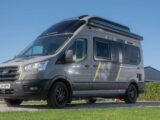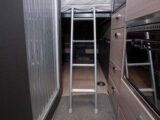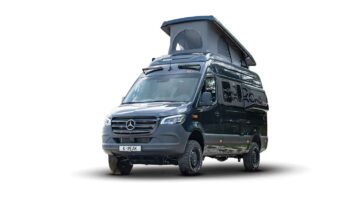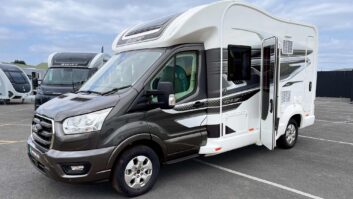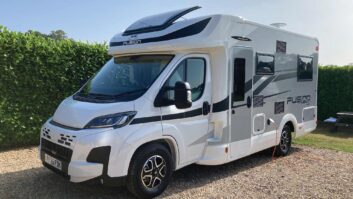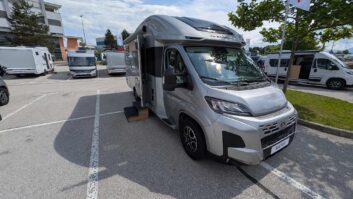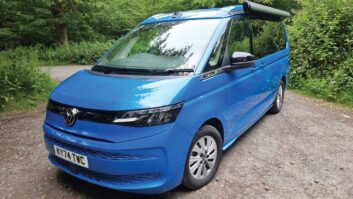Verdict
The Trekker X is perhaps the most activity-oriented of the three models now in the Trekker range. It still makes a very comfortable ’van for a family to holiday in – so long as they tend to dine out most of the time. It would also function very well as a day-to-day vehicle.
Pros
- Great driver assistance features fitted as standard
- Superior roofbed
Cons
- Very narrow kitchen is not particularly well lit
Swift’s Trekker is the rugged end of its campervan offering – a set of three vehicles aimed at those who take their adventures seriously, as opposed to the Monza (more of a mainstream pop-top camper) and the Carrera (van conversions for those who who aren’t so keen in going off-road).
The Trekker X is one of two models in the Trekker range that features a rising-roof, the other simply named Trekker. But while the latter has a conventional rear-lounge arrangement, the Trekker X, which we consider to be one of the best campervans, goes in for a rather more flexible layout. This arrangement should attract anyone who likes to combine their campervanning with outdoor sports.
I took the Swift Trekker X for a spin along the Yorkshire coastline, to see how it performed.
Exterior and cab
I think the Trekker X certainly looks the part, with a grey and black exterior smartly accented with yellow piping around the grille at the front.
What I initially thought were random bits of shading down the side are in fact a map of the world, only with all of the pieces jumbled up. It all looks very adventurous, and therefore very fitting.
Swift worked extensively with Ford to develop the Trekker range (it even had its public launch at a Ford site in Essex), which runs as standard on a 165bhp Ford Transit with six-speed manual transmission. We also consider the Ford Transit to be one of the best vans for converting to a camper.
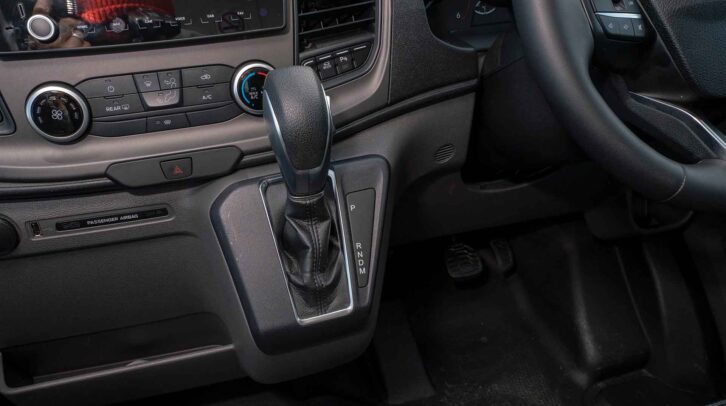
My test vehicle had the optional eight-speed automatic gearbox, although not with the rotary shift gear selection that new models will benefit from: rather, it was a standard gear lever for us.
The Ford cab is very comfortable and I really appreciated the sizeable touchscreen on the dash.

You also get an impressive range of extras fitted as standard, including cruise control, driver and passenger airbags, ESP with curve, load adaptive and roll stability control, emergency brake assist, lane-keeping system, rear-view camera, and front and rear parking aid. Add in other touring gadgets such as the best dash cam for a motorhome and a sat nav like the Garmin Camper 1095 and you will be well on your way to a stress-free driving experience.
I really like the more car-like drive the Ford offers you, although even with all of those controls, on sharper bends, the Trekker X did feel slightly more top-heavy than is usual with a campervan: at 2.98m, it is a bit higher than average for a rising-roof camper.
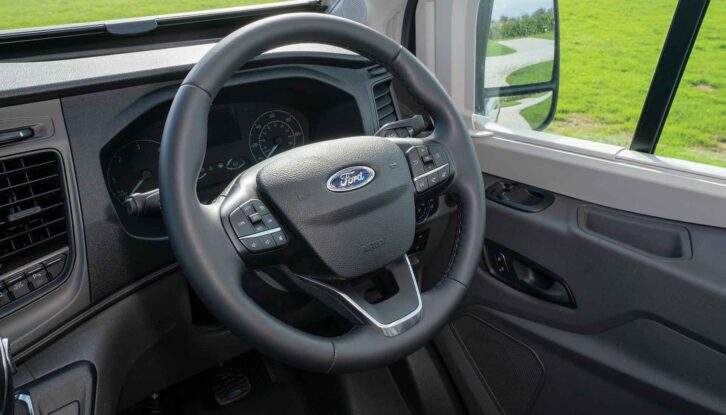
The cab seats come with armrests and are neatly branded as ‘Trekker’. There are also two travel seats in the rear lounge.
When it comes to setting up camp, the hook-up and water connections are both on the nearside front corner, while there is an external barbecue gas point on the offside.
Unusually, the external shower is halfway up the offside, rather than near the back. Given that the central area is where all other water uses are, this possibly makes sense, as it reduces the chance of there being a leaky pipe.
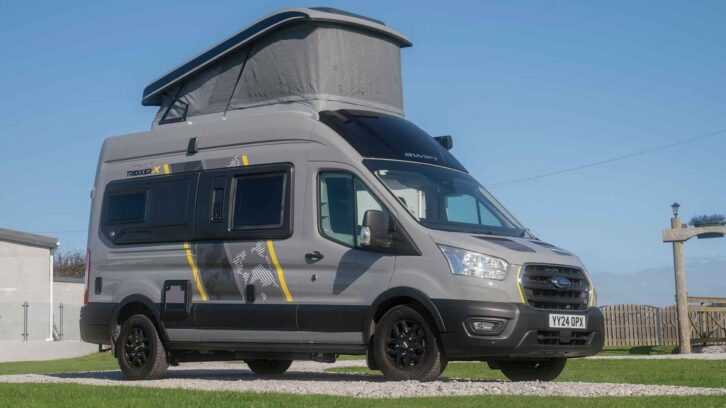
The toilet cassette access is also sited on the offside of the ’van, so if you were using the standard-fit awning (a 3.5m-long Thule Omnistor), it wouldn’t get in the way.
Lounging and dining in the Swift Trekker X
The control panel for the ’van, which is immediately above the sliding door, is very easy to understand – certainly more so than some similar panels I have seen in recent years.
Owing to the way the rear section is fitted out, the main seating area in the Trekker X is really just the front lounge. Still, I think it’s a cosy little area once the cab seats are swivelled.
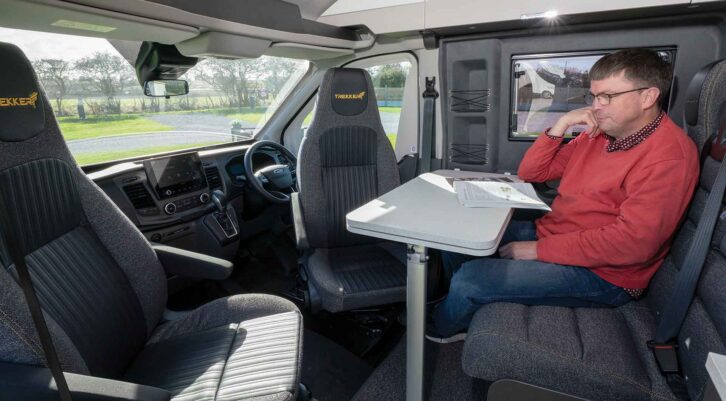
The clip-on table has an extension that swings out to make sure everyone can reach it. Alongside light coming through the windscreen and the large side windows, the lounge benefits from a Heki in the rising-roof, so daylight can come in from all angles, making for a really bright and airy interior. This will make it ideal for relaxing in once you’ve arrived at your chosen campervan campsite.
At night, things are lit up directly, with LEDs underneath the lockers, and indirectly, with more ambient lighting set in the small step up from the door to the lounge and from under the cloth storage pocket overhead.
The wooden panel on the side of the travel seats also has USBs, so whoever sits here shouldn’t feel they are being digitally excluded, even on the move.
Although the rear section beyond the narrow aisle between the kitchen and the washroom doesn’t offer seating options, it provides plenty of space for working on your bike out of the rain, for example, with storage to hand, just one of the features that saw our judging panel give it the title of best campervan for solo travel at the Practical Motorhome Awards 2025.

There’s even a speaker in the roof, so you can listen to your favourite music while you work.
This thoughtfully designed area can also double up as a useful zone to get dressed in. It’s well lit, with LED lights running down the nearside.
The kitchen in the Swift Trekker X
First impressions of the kitchen are fine, with a fold-out extension by the door and two sockets nearby, cleverly positioned in different directions to make plugging in easier.
Then there’s a two-burner gas hob and a small sink, with a combined oven and grill below.

The half-height Dometic 70-litre fridge has a more manageable position than normal, starting at waist height so you don’t have to bend down. It’s two-way opening – handy if you are already in bed or just want to reach out for a beer while you are working in the back. For those who need more chilling space, the best cool box for a campervan could offer a good solution.
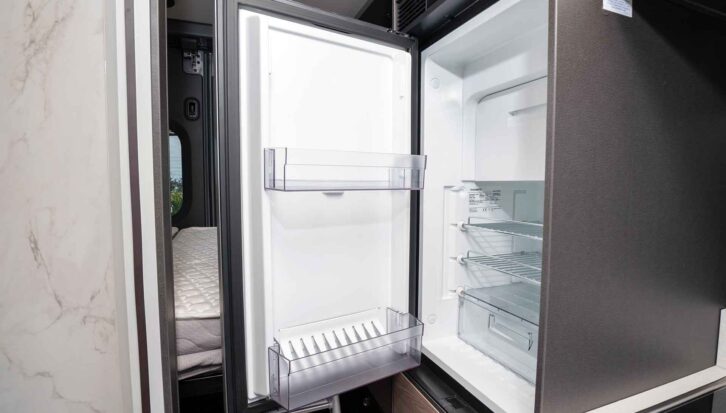
However, it’s impossible to ignore how narrow the aisle is here, making this quite a restricted area to cook in. Anyone wanting to get past the chef would really have to squeeze by.
The situation is not helped by the lighting here, either. The sink is only partially lit by the window, as it is off to one side. There are two LEDs under the locker, but they’d need to be on all day to make the kitchen workable.
The washroom in the Swift Trekker X
Given the narrowness of the central aisle in the Swift Trekker X, I reckon it is probably a good thing that the washroom is accessed through a tambour door.
Whatever your thoughts might be on the propensity of large tambour doors to get stuck, a conventional swing door in this position would have been rather too much to navigate.
There is a hook next to the door, too, where you can leave a towel or robe.
Inside, the marbled wall lining makes things feel a bit more homely. For those who have wondered “do campervans have showers?”, the Trekker X does – the large basin can be folded away to make more room for the shower – there’s clearly no room for a separate cabinet in here. But you get a separate showerhead: you don’t have to pull the unit out of the tap and then push it back in again.
I did find the room well lit and there’s also reasonable headroom here. But there’s no roof vent, so you can expect steam to be wafting out into the living area – taking a look at our guide to how to stop condensation in a campervan could help here.
The Thetford electric-flush cassette toilet has an 18-litre wheeled tank.
Sleeping in the Swift Trekker X
You make the transverse double bed at the back by uncoupling the two outer sections that are stored upright along the walls, then putting some struts across the gap in the middle to hold the central section, which you fold out.
The process is perhaps a bit fiddly, but the struts are held in place magnetically, so you get a solid and comfortable bed, although you can always take a look at my tips on how to make camper beds more comfortable if you want to improve your sleeping experience.

Spotlights underneath the locker make night-time reading easy, and there is even a small ladder up to the bed.

There is, of course, a larger ladder to take you up to the roof bed, and although it doesn’t get in the way of the lounge, you do have to get right to the top before you can climb onto the roof bed. I did find the access space a bit restricted for my 6ft+ height.
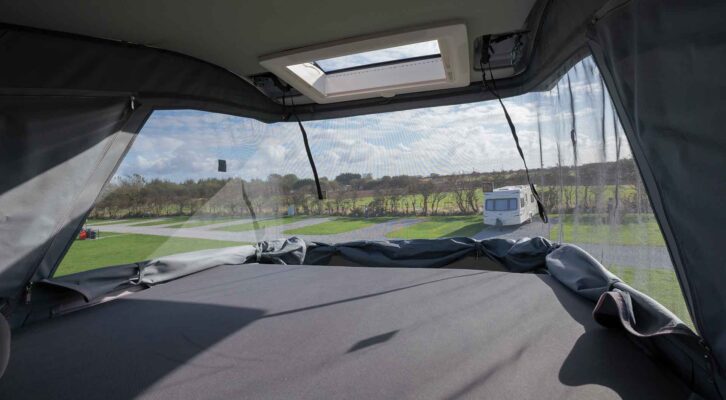
Once you get to it, however, the roof bed feels very superior, with a Heki complete with a blind and a flyscreen, a USB port and more spotlights.
Storage in the Trekker X
The campervan layout really lends itself to offering a wide range of storage options, another indication of its very thoughtful interior design.
The rear section, which broadens out after that narrow aisle to leave a space for bikes (such as the Ribble Allroad TI Enthusiast) complete with holds, manages to include two double cupboards below a huge drawer on the nearside.

There are more drawers on the offside, as well as one more cupboard that gives you internal access to the gas bottle, so you don’t necessarily have to go outside in the rain to turn it off.
On the offside, there are also a couple of large shelved overhead lockers. All of these compartments come with proper handles, albeit pushed into inlays for a smoother look, giving you good storage for all of those must-haves for a tour.

There’s a locker above the lounge and over that, another storage space, which you access by unzipping the fabric. As this doesn’t look like a storage area on first inspection, it could be a useful place for more valuable possessions.
There are retainers for water bottles and the like in the cab. The kitchen also has plenty of excellent storage options, although again, these are slightly compromised by the relative narrowness of that central aisle.
There are two overhead lockers above the kitchen worktop, and another one over the fridge, all of which are fine to reach. There is then a column of drawers under the fridge, two more under the oven, and a large cupboard to the right of it, but the lower recesses here are an awkward stretch down.
The washroom is less well provided for, but there is a small cupboard set behind a see-through panel here.
Equipment in the Trekker X
The Swift Trekker X looks as though it is built for serious adventuring, although there aren’t too many extras of the kind that would make it a serious off-road vehicle – there is no 4×4 option, for example.
But those kinds of extras tend only to appear on ’vans costing at least twice as much as the Trekker X and not boasting the level of dealer back-up you get with a Swift. They also often weigh far more than the Trekker X’s 3500kg MTPLM.
When compared with the fixtures and fittings found in conventional campers, the Trekker X stands up extremely well. For example, you get a Whale campervan heating system, two sets of TV sockets, speakers in the roof and a 110W solar panel, along with all those driver assistance features mentioned earlier.

And you still get a handy storage area in the back, complete with holds for your bikes. The roofbed is also better equipped than many I have seen.
A 3.5m-long Thule Omnistor awning in anthracite is fitted as standard, as is a powered step.
Alternatives to consider
Coming on a Ford Transit, the WildAx Meteor is a well-planned and thoughtfully designed two-berth which has a good double bed and a comfortable lounge area. The Panama P57 could be a good option for ‘van owners who want to head off grid in their campervan, with the pop-top option having an excellent level of spec.
The base vehicle
- Chassis: Ford Transit Engine 2.2-litre turbodiesel
- Power: 165bhp@3500rpm
- Torque: 405Nm@1750-2500rpm
- Transmission: Six-speed manual (eight-speed automatic transmission is a cost option)
- Features include: 70-litre fuel tank, Tyre Pressure Monitoring System, rain guards to all wheels, tyre repair inflation kit, low-energy LED lighting, 110W solar panel and regulator
The conversion
Ford Transit panel van in Grey Matter with improved front suspension, rising-roof in matching colour, gloss black front spoiler, black bumper and exterior panels with graphics, external cold water shower and BBQ point, 16” matt black alloy wheels with all-weather tread tyres, flush fitting, double glazed tinted acrylic side windows with night latch ventilation, rear Ford glazing with privacy glass, rising-roof with secure twist closing system and Heki.
Lounging and dining
Sangallo Elm woodgrain furniture, Oceania soft furnishings with stain-resistant fabrics, white locker doors with chrome inlay and concealed handles, zip pocket storage above lockers, dark grey Savoy fabric wall covering with stain-resistant finish on lower panels, moulded window surrounds and storage pockets in contrasting diamante fabrics, Ancares Oak plank-effect scratch-resistant floor, loose-fit bleachable carpets, forward-facing travel seats with Isofix on aisle seat, cassette blinds and flyscreens to all windows, anthracite interior formed décor panels to sliding and rear doors, flyscreen for sliding door, dual zip windows with midge screens in roof, two TV stations, USB ports in travel seats, speaker in roof at rear, LED lighting throughout, clip-on table in front lounge.
The kitchen
Dometic two-burner stainless-steel gas hob and sink with glass lids, combined oven and grill, Dometic 70-litre two-way opening compressor fridge, Appia laminate worktop
The sleeping setup
- Rear double bed: 1.85 x 1.37m
- Roof bed: 2.03 x 1.30m
Equipment includes
Digital dash incorporating DAB/FM radio with Apple Carplay/Android Auto, USB, Bluetooth and parking aids, cruise control, driver and passenger airbags, automatic cab air conditioning, extensive driver assistance package including ESP, lane-keeping and emergency brake assist, Whale heating and internal eight-litre water heating system, control panel with 4in LCD screen, insulated 65-litre fresh-water tank, 55-litre waste-water tank, four mains sockets and USB ports
Weights can be a confusing aspect of owning a ‘van – Peter Rosenthal is on hand to help, explaining the various aspects of motorhome weights that you need to know to help you stay safe and legal on the road.
If you’ve enjoyed reading this article, why not get the latest news, reviews and features delivered direct to your door or inbox every month. Take advantage of our brilliant Practical Motorhome magazine SUBSCRIBERS’ OFFER and SIGN UP TO OUR NEWSLETTER for regular weekly updates on all things motorhome related.
Technical Specifications
| Berth | 4 |
| MiRO | 3085 kg |
| Payload | 415 kg |
| MTPLM | 3500 kg |
| Shipping Length | 5.98 m |
| Width | 2.11 m |
| Engine Size | 2000 cc |





























